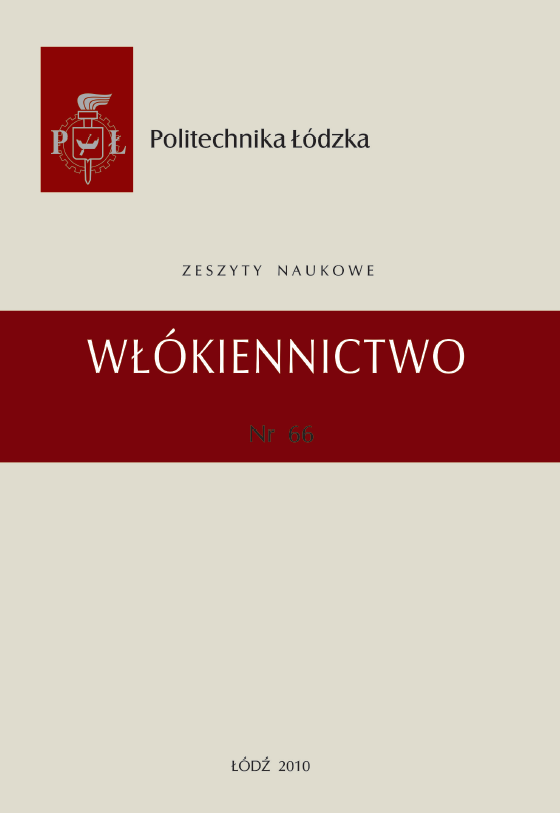Abstract
The objective of the research that was undertaken in PhD thesis, was to test out whether dyes, usually applied in order to bestow esthetic look of the textiles, can improve their barrier properties against harmful UV radiation, in a way that the product could be considered as UV protective. At the same time it was admitted that the theory, often encountered in the literature, that indicates the relation between the colour of the final product and its barrier properties, needs to be verified. It was assumed that decisive meaning in this case has the chemical structure of the dye and fibreformating polymer.
The choice of the class of investigated dyes (monoazo disperse dyesderivative of p-amino-p-nitroazobenzene) and fiberformating polymer (polyamid and polyester) allowed to assume that those dyes create a solid solution inside the fiber. Basing on that assumption the mathematically-physical models of dyed textile product used as an optical filter, absorbing and dispersing UV light were created. The transmittance analysis of dyed textile product, that used elaborated models, allowed to classify investigated dyes as UV radiation absorbents.
It was confirmed that the ability of the fiber to increase the barrier properties of the textiles in UV zone, first of all depends on chemical structure of the dye and fiberformating polymer. The elaboration of mathematically-physical models of dyed textiles as a UV radiation filters, enables to put into effect the utilitarian purpose of the PhD research. That is the creation of the basis of automatic textile colour reciping of already determined permeability properties against UV radiation and the opportunity of their prognosis.
References
www.who.int/entity/uv/publications/proUVrad.pdf
Gambichler T. i in.: Protection against ultraviolet radiation by commercial summer clothing: need for standardised testing and labelling. BMC Dermatology 2001, 1:6
Gambichler T. i in.: UVA and UVB Transmission of Fabrics: Critical Wavelength Based on Absorbance and Effective Dose. Exogenous Dermatology 2002, 1, 290.
Dummer R., Osterwalder U.: UV transmission of summer clothing in Switzerland and Germany. Dermatology 2000, 200, 81.
Adam J.: Sun-protective clothing. J Cutan Med Surg. 1998, 3, 1, 50.
Gambichler T. i in.: Role of clothes in sun protection. Recent Results Cancer Res. 2002, 160, 15.
PN-EN 13758-1 Tekstylia. Właściwości ochronne przed działaniem promieniowania UV. Część 1: Metoda badania płaskich wyrobów włókienniczych.
Australian/New Zeland Standard AS/NZS 2604 (1993) (poprawiona w 1997 i w 1998 roku).
PN-79/T-06590 Ochrona przed promieniowaniem optycznym. Mierniki promieniowania nadfioletowego.
Praca zbiorowa. Kryteria zdrowotności środowiska. Promieniowanie UV. Instytut Medycyny Pracy. Łódź 1996 r.
Palacin F.: Textile Hochveredlung schützt vor UV-Strahlung. Textilveredlung 1996, 31, 11/12, 235.
Palacin F.: Textilausrüstung schützt vor UV-Strahlung. Melliand Textilberichte 1997, 7/8, 519.
Achwal W.B.: UV protection by textiles. Colourage 2000, 4, 50.
Reinert G. i in.: Sonnenschutzeigenschaften textiler Flächen und deren Verbesserung. Textilveredlung 1996, 31, 11/12, 227.
Böhringer B. i in.: UV-Schutz durch Textilien. Melliand Textilberichte 7-8, 1997, 522.
Laperre J., Gambichler T.: Sun protection offered by fabrics: on the relation between effective doses based on different action spectra. Photodermatol Photoimmunol Photomed. 2003, 19, 1, 11.
Kaspar K. i in.: Bestimmung des UV-Schutzes von leichten Sommergeweben in vitro und in vivo. Textilveredlung 1999, 6, 536.
Fössel M. i in.: Praktische Erfarungen mit Solartex-Produkten bei der Ausrüstung von Sonnenschutzkleidung. Melliand Textilberichte 1997, 7/8, 515.
Davis S. i in.: Clothing as protection from ultraviolet radiation: which fabric is most effective? Int. J Dermatol. 1997, 36, 5, 374.
Urbańczyk G.W.: Fizyka włókna. Wyd. PŁ, 2002.
Rydzewska D.: Spektrofotometryczna analiza przebiegu zjawiska płowienia wybarwień wyrobów włókienniczych. Praca doktorska (Wydział Włókienniczy PŁ), Łódź 1970.
Dumitrescu I., Visileanu E., Niculescu M.: Odzież ochronna przeciw promieniowaniu nadfioletowemu. Referat wygłoszony na Konferencji Ekotextil 1999 r.
Knittel D. i in.: Transmissionsmessungen an Textilien. Melliand Textilberichte, 1999, 4, 281.
Jędrzejewski W.: Wpływ promieniowania UV na organizmy żywe i ich ochrona przez stosowanie określonych wyrobów włókienniczych. Przegląd Włókienniczy 1995, 10,16.
Jędrzejewski W.: Wpływ promieniowania UV na organizmy żywe i ich ochrona przez stosowanie określonych wyrobów włókienniczych. Przegląd Włókienniczy 1995, 11, 21.
www.gsf.de/flugs/UV_Schutz_Textilien.pdf
Abidi N. i in.: Cotton fabric and UV-protection. Reprinted from the “Proceedings of the Beltwide Cotton Conference” 2001, 2, 1301.
Schuller M. I.: Remington W.R., Dis. Farad. Soc. 1954, 16, 201.
Gawłowski A.: Synteza i właściwości barwników azowych pochodnych N-benzyloaniliny. Praca doktorska (Wydział Chemiczny PŁ), Łódź 1986.
Riva A., Algaba I.M., Pepio M.: Action of a finishing product in the improvement of the ultraviolet protection provided by cotton fabrics. Modelisation of the effect. Cellulose 2006, 6, 13, 697.
Algaba I., Pepio M., Riva A.: Modelisation of the Influence of the treatment with Two Optical Brighteners on the Ultraviolet Protection Factor of Cellulosic Fabrics. Ing. Eng. Chem. Res. 2007, 46, 2677.

